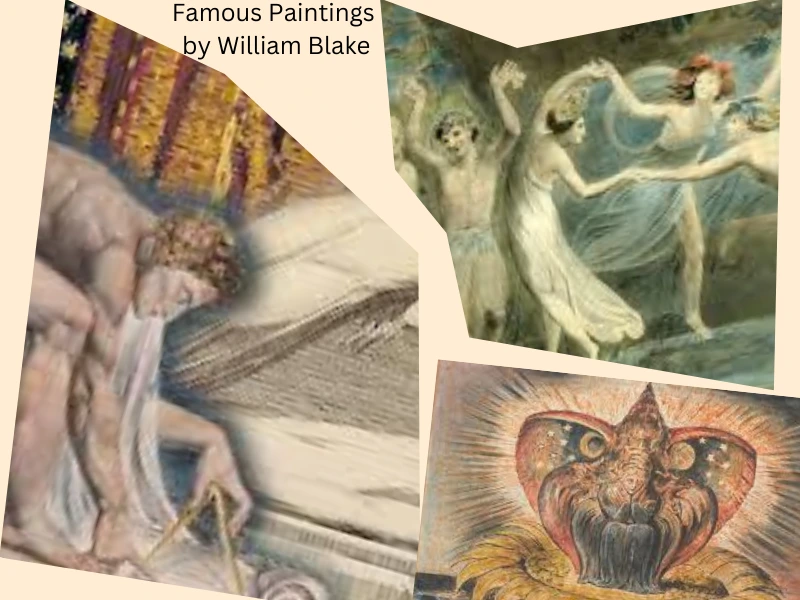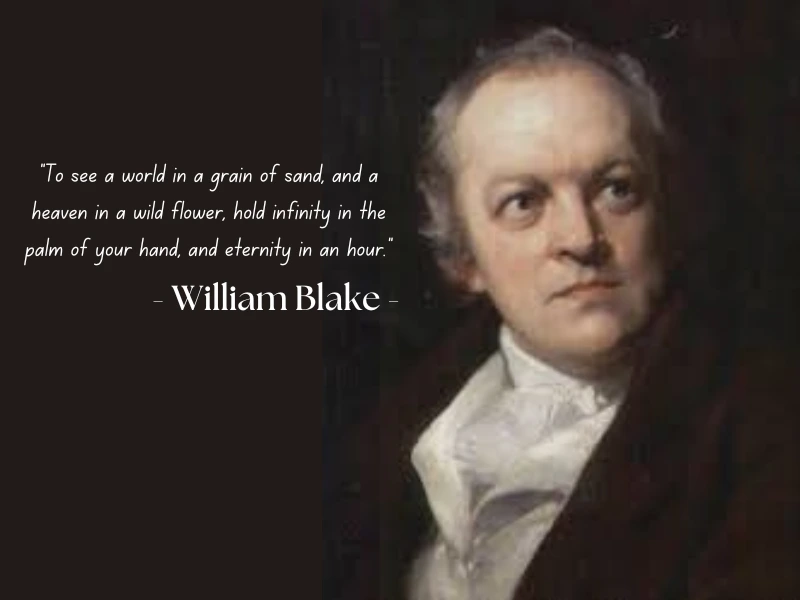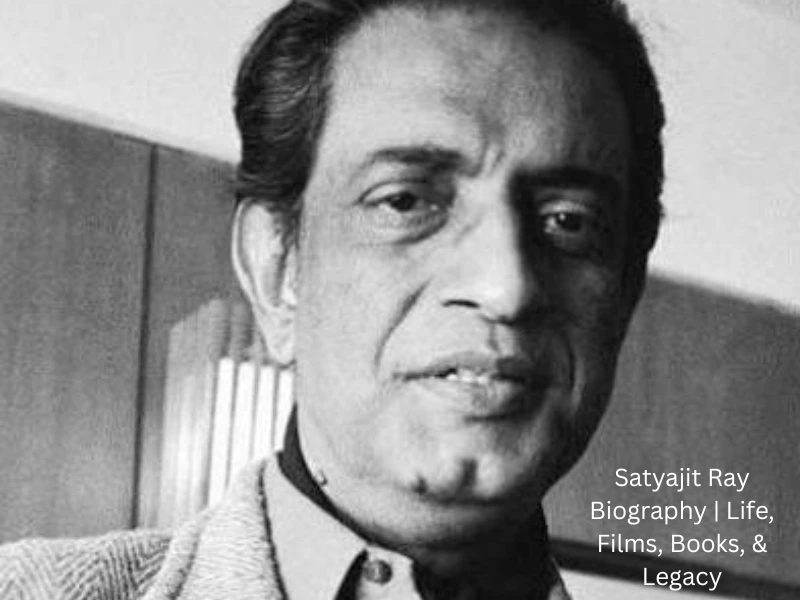William Blake: The Visionary Poet, Painter, and Philosopher of the Romantic Era
| Born | 28 November 1757 |
| Died | 12 August 1827 |
| Education | Royal Academy of Arts |
| Occupation | Poet * Painter * Printmaker |
| Notable works | Songs of Innocence and of Experience, The Marriage of Heaven and Hell, The Four Zoas, Jerusalem, Milton, “And did those feet in ancient time” |
| Country | England |
This is William Blake, a leading figure in art and literature—a poet, painter, and engraver who had a very great effect on the world of art and literature. He is often assumed to be a significant figure of Romanticism, as all his visionary works point at this fact.
Early Life and Background
William Blake was born on November 28, 1757, in London, England, to James and Catherine Blake. He proved to be an artistic child since early childhood; he made sketches of designs and pursued imaginative themes at a young age. Considering his aptitude, William Blake was sent to drawing school at the age of ten.
By fourteen, he worked as an apprentice to the engraver James Basire, a decision that greatly influenced all his later works. Basire introduced Blake to Gothic art, which would be often repeated in his creations, and despite little formal schooling, Blake’s exposure to literature and religious texts also shaped his unique perspective upon the world.
William Blake as a Poet
The richness in symbolism and visionary style characterized Blake’s poems with complexity in themes. He always explored the duality of such things as songs of innocence and experience, as well as spirituality and materialism. One of his most acclaimed collections is called Songs of Innocence and of Experience.
The poems in Songs of Innocence (1789) portray life as innocent and idyllic, while Songs of Experience (1794) reveal a darker reality. This juxtaposition shows Blake’s belief about the balance between opposing forces in life. Lines like “Tyger Tyger, burning bright” from The Tyger are iconic, where he is able to use powerful imagery and provoke deeper thought.
William Blake as a Painter and Illustrator
Apart from his poetry, the talent of being a painter and illustrator also distinguished him. He mostly used to attach his artworks with the written ones so that the readers could experience the integrated output. The visual style was heavily influenced by Gothic art and religious imagery and featured bold lines, vivid colors, and intricate details.
Some of the most famous illustrations he ever made are those for “The Book of Job and Dante’s Divine Comedy“. These works show his ability to fuse spiritual themes with striking visuals, giving a glimpse into mystical visions.
Philosophical and Spiritual Beliefs
The spirituality within his work is what made Blake’s philosophy. He rejected organized religion but had a deep, personal connection to God and the divine. His visionary experiences, which he claimed involved encounters with angels and prophets, profoundly shaped his philosophy.
With such works as “The Marriage of Heaven and Hell,” Blake criticized traditional thinking regarding morality. His concepts of good and evil, therefore, could be mutually inclusive. With his mysticism and visionary ideas, Blake was a trendsetter for humanity’s awareness of consciousness and spirituality.
Major Works of William Blake
These creations are numerous and diverse, yet several masterpieces distinguish the work of Blake as having contributed to his legacy.
Analysis of The Tyger
One of Blake’s best-known poems, The Tyger, examines the nature of creation and destruction. It raises questions about the character of the creator: “Did he who made the Lamb make thee?” The tiger represents savage beauty and untamed might, a counterpoint to the gentleness of the lamb, which appears throughout his work.
The rhythmic structure of the poem with its pounding beat mirrors the presence of the tiger. Blake’s use of vivid imagery and rhetorical questions engages the reader, making them ponder the mystery of existence.
The Significance of Jerusalem: The Emanation of the Giant Albion (1804)
The hymn, Jerusalem, of Blake has now been regarded as an emblem of hope and resilience. In it, he reflects the deep yearning for a utopian vision of England: “And did those feet in ancient time / Walk upon England’s mountains green?”.
The hymn is part of his larger prophetic work, Milton, which explores the themes of personal and collective redemption. Today, it is celebrated as a patriotic anthem, but its roots lie in Blake’s complex spiritual philosophy.
Influence of The Marriage of Heaven and Hell (1790)
This prose-poem challenges religious dogma and fuses witty satire with deep philosophical insights. Blake propounds the view that contraries are necessary for advancement when he writes, “Without contraries is no progression.”
The work has in it the famous Proverbs of Hell, paradoxical aphorisms, like “The road of excess leads to the palace of wisdom.” The radicalism of ideas coupled with its imaginative style stamped Blake as a revolutionary thinker.
Famous Poems by William Blake
William Blake, a visionary poet of the Romantic era, is best known for his evocative and symbolic poetry. His works cover themes of innocence, experience, spirituality, and human existence, often complemented by his beautiful illustrations. Some of his most notable poems include:
1. The Tyger
From: Songs of Experience
“Tyger Tyger, burning bright,
In the forests of the night;
What immortal hand or eye,
Could frame thy fearful symmetry?”
This poem looks at the duality of creation, where it is amazed at the beauty and terror of the tiger. Its rhythmic structure and profound questions on the creator make it one of Blake’s most famous works.
2. The Lamb
From: Songs of Innocence
“Little Lamb, who made thee?
Dost thou know who made thee?”
A companion to The Tyger, the poem describes innocence and purity through the imaginative form of a lamb and reflects on Blake’s belief in spirit, contrasting that with the lamb God and the terrifying tiger.
3. London
From: Songs of Experience
“I wander thro’ each charter’d street,
Near where the charter’d Thames does flow,
And mark in every face I meet
Marks of weakness, marks of woe.”
Blake is highly critical of the oppressive conditions of his society. The themes include poverty, suffering, and corruption in urban life. The imagery in the poem brings out the despair of industrial London.
4. A Poison Tree
From: Songs of Experience
“I was angry with my friend:
I told my wrath, my wrath did end.
I was angry with my foe:
I told it not, my wrath did grow.”
This poem describes the consequences of pent-up anger by using the metaphor of a growing tree that bears poisonous fruit. Its moral lessons and haunting tone make it timeless.
5. The Chimney Sweeper
From: Songs of Innocence and of Experience
“When my mother died I was very young,
And my father sold me while yet my tongue
Could scarcely cry ‘weep! ‘weep! ‘weep! ‘weep!
So your chimneys I sweep, and in soot I sleep.”
This poignant poem throws a light on 18th-century child labourers in England. Societal injustice is critiqued here by contrasting innocence and exploitation.
6. Holy Thursday
From: Songs of Innocence and Songs of Experience
“Is this a holy thing to see,
In a rich and fruitful land,
Babes reduced to misery,
Fed with cold and usurous hand?”
Blake juxtaposes the assumed piety of society with the hypocrisy of society. By this, he condemned children and the poor. Two versions show his concerns over society and morality.
7. Jerusalem
“And did those feet in ancient time
Walk upon England’s mountains green?
And was the holy Lamb of God
On England’s pleasant pastures seen?”
A hymn of hope and spiritual renewal, Jerusalem has become a national symbol of resilience and inspiration. It reflects Blake’s vision of a divine and utopian England.
Blake’s Influence on Romanticism
As a precursor to the Romantic Movement, Blake’s works encapsulated many of its core principles: individualism, emotion, and a connection to nature. His emphasis on imagination and spirituality resonated with contemporaries like William Wordsworth and Samuel Taylor Coleridge.
This made him stand out in the sense that his approach was different. The other Romantic poets focused on natural landscapes, but Blake went to the inner landscapes of the soul. His work has inspired a deeper understanding of human experience and has influenced generations of poets and artists.
Criticism and Controversies
In his lifetime, Blake was viewed as a man with quite unusual ideas and artistic sensibilities. Critics dismissed him as eccentric, referring to his visions as madness rather than genius. His self-published works, created by his innovative relief-etching technique, did not garner much recognition.
Despite all this criticism, Blake continued to produce his work. It was only after his death on August 12, 1827, that the genius he possessed was finally realized. He is now one of the most original and forward-thinking artists in history.
Blake’s Legacy in Modern Times
William Blake’s influence has been felt beyond the Romantic era. Many writers, musicians, and filmmakers, such as Allen Ginsberg, Bob Dylan, and Jim Morrison, have drawn inspiration from his work. His mystical themes and symbolic imagery are still resonating in modern art and culture.
Blake’s works are studied in academia, but his paintings and engravings are seen in the world’s top galleries. His ability to integrate art, literature, and philosophy ensures that his work lives on with vigor.
Interesting Facts About William Blake
- Blake was claiming visions of angels and otherworldly beings at a young age.
- He was heavily influenced by the Bible, which he viewed as the ultimate source of artistic inspiration.
- Blake’s wife, Catherine, helped him in the production of his illuminated books and was his most devoted supporter.
- Blake is known throughout the world, but he experienced financial hardship for most of his life.
- He even developed his own type of printing technique called relief etching to perfectly link his poetry and art forms.
Blake’s Unique Style: Poetry and Art Combined
One of Blake’s defining features was that he was a master at combining text and images. His illuminated books, Songs of Innocence and of Experience, for instance, are composed of poems surrounded by beautiful illustrations. This blending of art and literature was revolutionary and enabled the reader to be in his vision on so many levels.
The rigid boundaries created by his time did not define Blake’s work but instead showed how art and poetry were two interlinking expressions of the human spirit. His work therefore inspires multimedia artists and writers.
Exploring Blake’s Symbolism
Blake’s works abound in symbolism that brings multiple understandings. Such examples as the lamb and the tiger mean innocence and experience, while the city of Jerusalem epitomizes the enlightened side. Fire was always present to signify a change in a man as well as energy from above.
These symbols transcend their immediate context and speak to universal themes like the struggle between light and darkness, creation and destruction, and good and evil. Understanding Blake’s symbolism provides deeper insight into his complex worldview.
William Blake’s Contribution to Spirituality
Blake’s spiritual thinking was more against the prevailing religious traditions and instead emphasized self-enlightenment rather than institutionalized doctrines. He always believed in the existence of God in everyone and thus preached self-discovery and self-development. His works reflected a kind of mysticism, portraying his search for divine truth. Through blending art, poetry, and spirituality, Blake composed a work of art that reflects the immortal human longing for meaning and connection.
Why William Blake Remains Relevant Today
The timeless issues he pursues, including morality, imagination, and the human spirit, keep him within our current horizon. For a society to find individuality and individuality freedom is something that resonates in Blake’s critique of social mores and in his rejoicing in individualism, which makes him a torchbearer among free thinkers.
His literature makes readers think of challenging assumptions and more engaging arts, literature, and philosophy. He provides spiritual insight in an age with growing materialism.
Also read Charles Dickens Biography
Famous Paintings by William Blake
Here’s a look at some of his most iconic paintings and illustrations:
1. The Ancient of Days (1794)
Medium: Relief etching with watercolor
This iconic image is one of Blake’s most famous. It depicts a bearded, godlike figure crouching with a compass in hand, symbolizing creation and divine order. The vibrant colors and dramatic composition showcase Blake’s mastery of visual storytelling. Originally used as the frontispiece for Europe: A Prophecy, it embodies his fascination with divine geometry and cosmic forces.
2. Newton (1795)
Medium: Monoprint with watercolor
Blake portrays Sir Isaac Newton as a symbol of materialistic reasoning, contrasting the scientific worldview with his own spiritual beliefs. Newton is shown absorbed in measuring with a compass, surrounded by darkness, representing the limits of empirical knowledge. This work challenges the Enlightenment’s focus on logic and reason over imagination.
3. The Great Red Dragon Series (1805–1810)
Medium: Watercolor
Blake’s Great Red Dragon series, based on the Book of Revelation, features four dramatic paintings:
- The Great Red Dragon and the Woman Clothed with the Sun
- The Great Red Dragon and the Beast from the Sea
- The Great Red Dragon and the Beast from the Earth
- The Number of the Beast is 666
These paintings depict apocalyptic visions, with the dragon symbolizing evil and spiritual conflict. The dynamic poses and vivid imagery capture the intense drama of biblical prophecy.

4. God Judging Adam (1795)
Medium: Monoprint with watercolor
Blake’s interpretation of Adam and God after the Fall of Man is filled with tension and movement. Adam is depicted recoiling, while God looms above him, embodying judgment and authority. The stark contrast between the figures emphasizes the theme of guilt and redemption.
5. The Last Judgment (c. 1809)
Medium: Pen and ink with watercolor
This large and complex painting depicts the biblical Last Judgment, with Christ presiding over the separation of the righteous from the damned. The intricate composition and vivid imagery reflect Blake’s profound spiritual vision.
6. Job Series (1821–1826)
Medium: Engravings
The Book of Job illustrations by Blake are masterpieces of biblical art. The 21 plates describe Job’s trials, faith, and ultimate restoration. Each of the plates is accompanied by verses that reflect the seamless blend of visual and textual storytelling ability by Blake. Key works from the series include:
- Satan Smiting Job with Boils
- Job and His Comforters
- The Lord Answering Job out of the Whirlwind
7. Glad Day (Albion Rose) (c. 1794)
Medium: Relief etching with watercolor
This uplifting image symbolizes human freedom and joy. A radiant figure stands with arms outstretched, representing Albion, a mythical figure in Blake’s mythology who embodies the human spirit. The vibrant colors and dynamic pose make it one of Blake’s most optimistic works.
50 Powerful William Blake Quotes
On Life and Imagination
- “Imagination is the real and eternal world of which this vegetable universe is but a faint shadow.”
- “The tree which moves some to tears of joy is in the eyes of others only a green thing that stands in the way.”
- “What is now proved was once only imagined.”
- “I must create a system or be enslaved by another man’s; I will not reason and compare: my business is to create.”
- “A fool sees not the same tree that a wise man sees.”
On Love and Compassion
- “Love seeketh not itself to please, nor for itself hath any care, but for another gives its ease, and builds a Heaven in Hell’s despair.”
- “He who loves feels love’s presence everywhere.”
- “And we are put on earth a little space, that we may learn to bear the beams of love.”
- “The bird a nest, the spider a web, man friendship.”
- “The soul of sweet delight can never be defiled.”
On Duality and Contraries
- “Without contraries is no progression. Attraction and repulsion, reason and energy, love and hate, are necessary to human existence.”
- “The road of excess leads to the palace of wisdom.”
- “You never know what is enough unless you know what is more than enough.”
- “Joy and woe are woven fine, a clothing for the soul divine.”
- “The tygers of wrath are wiser than the horses of instruction.”
On Freedom and Rebellion
- “Those who restrain their desire do so because theirs is weak enough to be restrained.”
- “The man who never alters his opinion is like standing water, and breeds reptiles of the mind.”
- “I will not cease from mental fight, nor shall my sword sleep in my hand.”
- “To see a world in a grain of sand and a heaven in a wild flower, hold infinity in the palm of your hand, and eternity in an hour.”
- “If the doors of perception were cleansed, everything would appear to man as it is, infinite.”
On Religion and Spirituality
- “God appears, and God is light, to those poor souls who dwell in night; but does a human form display to those who dwell in realms of day.”
- “Prisons are built with stones of law, brothels with bricks of religion.”
- “Christ’s crucifix shall be made an excuse for executing criminals.”
- “Mercy is the golden chain by which society is bound together.”
- “A truth that’s told with bad intent beats all the lies you can invent.”
On Art and Creativity
- “Art can never exist without naked beauty displayed.”
- “The imagination is not a state: it is the human existence itself.”
- “Everything to be imagined is an image of truth.”
- “Eternity is in love with the productions of time.”
- “Painting is no less an art than poetry.”
On Nature
- “Great things are done when men and mountains meet.”
- “The glory of the world is to see, to feel, to act; its true value lies in this union.”
- “Nature has no outline, but imagination has.”
- “To see the infinite in every small thing, you need to see as Blake sees.”
- “When the sun rises, do you not see a round disk of fire somewhat like a guinea? Oh no, no, I see an innumerable company of the heavenly host crying, ‘Holy, holy, holy is the Lord God Almighty.’”
On Knowledge and Wisdom
- “He who binds to himself a joy does the winged life destroy; but he who kisses the joy as it flies lives in eternity’s sunrise.”
- “The child’s toys and the old man’s reasons are the fruits of the two seasons.”
- “If others had not been foolish, we should be so.”
- “The foundation of empire is art and science. Remove them or degrade them, and the empire is no more.”
- “Truth can never be told so as to be understood, and not be believed.”
On Vision and Perception
- “The eye altering alters all; the senses roll themselves in fear, and the flat earth becomes a ball.”
- “My eyes are always open to see the infinite.”
- “What is a man if not a visionary? A corpse clothed in shadows.”
- “Vision is the power of seeing beyond the horizon.”
- “Where man is not, nature is barren.”
On Human Nature
- “Man was made for joy and woe; and when this we rightly know, through the world we safely go.”
- “The weak in courage is strong in cunning.”
- “Every harlot was a virgin once.”
- “One thought fills immensity.”
- “What is now proved was once only imagined.”
Conclusion
William Blake’s life and work are the essence of a true visionary. With his evocative poetry and mesmerizing art, he challenged conventional thought and inspired generations to come. While he was not understood by his contemporaries, today, his legacy stands bright as a testament to the lasting power of imagination and individuality.
FAQs
What is William Blake best known for?
William Blake is best known for his visionary poetry, such as Songs of Innocence and of Experience, and his innovative paintings and engravings, which often explored themes of spirituality, imagination, and human existence.
What is the most famous quote of William Blake?
One of Blake’s most famous quotes is:
“To see a world in a grain of sand, and a heaven in a wild flower, hold infinity in the palm of your hand, and eternity in an hour.”
What is William Blake remembered for?
Blake is remembered as a pioneering Romantic poet and artist whose works combined profound philosophical insights, rich symbolism, and a unique fusion of text and imagery.
What was William Blake’s philosophy?
Blake’s philosophy emphasized the power of imagination, the interconnectedness of opposites (such as good and evil), and the importance of spiritual enlightenment over materialism or institutional religion.




Wow that was unusual. I just wrote an very long comment but after I clicked submit my comment didn’t appear. Grrrr… well I’m not writing all that over again. Anyways, just wanted to say superb blog!
Glad to be one of several visitors on this awe inspiring site : D.
Howdy would you mind letting me know which web host you’re working with? I’ve loaded your blog in 3 completely different web browsers and I must say this blog loads a lot quicker then most. Can you recommend a good internet hosting provider at a honest price? Thank you, I appreciate it!
Simply want to say your article is as astounding. The clarity on your post is simply great and i can suppose you are an expert in this subject. Well with your permission let me to clutch your RSS feed to keep updated with impending post. Thank you one million and please carry on the gratifying work.
Hey there! I’ve been readiing yohr web site for some time now annd finally got the courage to go ahead annd give you a shout
out from Atascocita Tx! Just wanted to mention keep up the fantastic job! https://Hallofgodsinglassi.wordpress.com
I truly appreciate this post. I’ve been looking all over for this! Thank goodness I found it on Bing. You have made my day! Thx again
I would like to thnkx for the efforts you have put in writing this web site. I am hoping the same high-grade web site post from you in the upcoming as well. In fact your creative writing skills has encouraged me to get my own blog now. Really the blogging is spreading its wings quickly. Your write up is a great example of it.
Incredible! This blog looks just like my old one! It’s on a totally different topic but it has pretty much the same page layout and design. Wonderful choice of colors!
F*ckin’ awesome things here. I’m very glad to see your post. Thanks a lot and i am looking forward to contact you. Will you please drop me a e-mail?